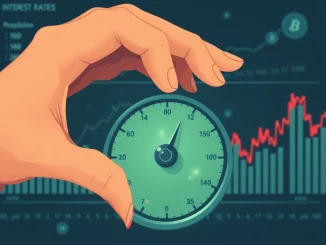
Is the United States teetering on the brink of a recession? Former U.S. Treasury Secretary Janet Yellen has sounded the alarm, pointing fingers directly at the economic policies enacted during Donald Trump’s presidency. In a candid interview with CNN International, Yellen didn’t mince words, stating that these policies are not just ineffective, but actively contributing to an increased probability of a significant economic downturn.
Why is Janet Yellen so concerned about the US Recession Risk?
Janet Yellen, a highly respected figure in economics and former Chair of the Federal Reserve, brings considerable weight to her pronouncements. Her recent statements aren’t just casual opinions; they are grounded in a deep understanding of economic mechanisms and historical precedents. Yellen specifically highlighted that the US recession risk has escalated due to the lingering effects of policies implemented under the Trump administration. Let’s break down her key concerns:
- Harmful Economic Policies: Yellen explicitly stated that Trump’s economic strategies are “proving to be harmful.” While she didn’t delve into exhaustive specifics in this brief interview snippet, her statement implies a broader critique of policies that may have created imbalances or vulnerabilities within the U.S. economy.
- Increased Recession Probability: The core of Yellen’s message is clear: the likelihood of a recession has grown. This isn’t just a minor adjustment in economic outlook; it’s a significant warning from a seasoned economist who has navigated numerous economic cycles.
- Treasury Yields and Tariff Postponement: Yellen linked the recent surge in Treasury yields to Trump’s decision to postpone reciprocal tariffs. This connection suggests that market reactions, specifically in the bond market, are influencing policy decisions and perhaps reflecting underlying economic anxieties.
To truly understand the gravity of Yellen’s warning about the US recession risk, it’s crucial to consider the context of Trump’s economic policies and their potential ramifications.
Decoding Trump’s Economic Policies: What are the risky elements?
While Yellen’s statement is concise, it alludes to specific aspects of Trump’s Trump economic policies that are now being scrutinized for their potential negative impact. To gain a clearer picture, let’s examine some of the key policies enacted during his term that economists often point to when discussing potential economic vulnerabilities:
- Tax Cuts and Fiscal Stimulus:
- The Tax Cuts and Jobs Act of 2017: This legislation significantly reduced corporate and individual income taxes. While proponents argued it would spur economic growth, critics raised concerns about its impact on national debt and potential for overheating the economy.
- Short-Term Boost, Long-Term Strain?: While tax cuts can provide a short-term economic boost, they can also lead to increased government borrowing and potentially unsustainable levels of debt, especially if economic growth doesn’t materialize as projected.
- Trade Protectionism and Tariffs:
- Trade Wars: Trump’s administration initiated trade disputes with several countries, imposing tariffs on imported goods, including those from China, the European Union, and Canada.
- Impact on Businesses and Consumers: Tariffs can increase costs for businesses that rely on imported materials and ultimately lead to higher prices for consumers. They can also provoke retaliatory tariffs, harming export-oriented industries.
- Supply Chain Disruptions: Trade wars can disrupt global supply chains, creating uncertainty and inefficiencies for businesses operating internationally.
- Deregulation:
- Rollback of Regulations: The Trump administration pursued a policy of deregulation across various sectors, arguing it would reduce burdens on businesses and stimulate economic activity.
- Potential Risks: While deregulation can sometimes foster innovation and efficiency, excessive deregulation can lead to environmental damage, financial instability, and reduced consumer protection in the long run.
Yellen’s mention of Treasury yields and tariff postponement adds another layer to this discussion. What is the connection?
Treasury Yields Surge: A Signal of Economic Anxiety?
The bond market, and specifically Treasury yields, are often seen as barometers of economic sentiment. A surge in Treasury yields can indicate various things, but in the context of Yellen’s statement, it likely points towards increased investor anxiety about the economic outlook. Here’s why:
- Rising Yields, Rising Concerns: When investors become more concerned about economic risks, they may demand higher returns (yields) to hold government bonds, especially longer-term bonds. This can lead to an increase in Treasury yields.
- Inflationary Pressures: Surging yields can also reflect expectations of higher inflation. If investors anticipate that inflation will rise, they will demand higher yields to compensate for the erosion of purchasing power over time.
- Impact on Borrowing Costs: Rising Treasury yields have ripple effects throughout the economy. They can increase borrowing costs for businesses and consumers, making it more expensive to finance investments and purchases. This can further dampen economic activity.
Yellen suggesting that the surge in Treasury yields influenced Trump’s decision to postpone tariffs is noteworthy. It implies that market signals, reflecting potential economic unease, might be forcing policy adjustments. However, the underlying concerns about the economic downturn remain.
Navigating the Economic Uncertainty: What can be done?
While Janet Yellen’s assessment paints a concerning picture of increased US recession risk, it’s important to remember that economic forecasts are not set in stone. Here are some potential factors and actions that could influence the economic trajectory:
- Policy Adjustments: Current and future administrations have the power to adjust economic policies. Fiscal and monetary policies can be tweaked to mitigate recessionary pressures and promote sustainable growth.
- Global Economic Conditions: The US economy is interconnected with the global economy. Global growth, trade relations, and geopolitical stability all play a role in shaping the US economic outlook.
- Technological Innovation: Breakthroughs in technology can drive productivity growth and create new economic opportunities, potentially offsetting some of the recessionary risks.
- Consumer and Business Confidence: Sentiment matters. If consumers and businesses remain confident, they are more likely to spend and invest, which can help sustain economic activity.
Conclusion: Heeding the Warning Signs
Janet Yellen’s stark warning about the increased US recession risk stemming from Trump’s Trump economic policies should not be taken lightly. Her expertise and experience lend credibility to her assessment. While the future is uncertain, her analysis underscores the importance of careful economic stewardship and the potential long-term consequences of policy decisions. It serves as a critical reminder that economic policies have far-reaching effects and require prudent, forward-thinking approaches to ensure stability and prosperity. The coming months will be crucial in observing how these economic dynamics unfold and whether the US can navigate these challenges to avert a potential recession.



